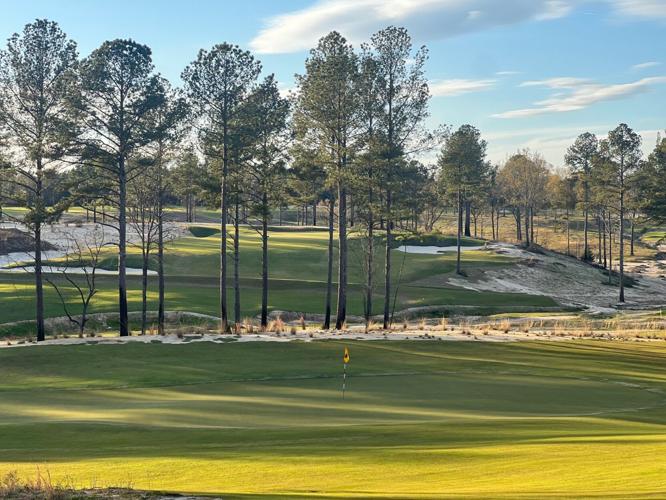AUGUSTA — Built nearly a century ago, Augusta National Golf Club has evolved into the model for the modern, high-end private club.
An exclusive membership made up of golfers from around the world. A unique 18-hole layout that is considered one of the best in the world. And private cabins and fine dining available so members don’t have to leave the grounds.
Just across the Savannah River, Aiken County is becoming a hotbed of private clubs. Sage Valley Golf Club opened in 2001 and has followed the Augusta National model, but in recent years two more private clubs have opened. And more are reportedly on the way.
The Tree Farm and Old Barnwell are two new clubs that are up and running, and a year ago Cypress Shoals was reported to be next with two layouts and more planned along the river near North Augusta and Edgefield County. Since then, the 21 Golf Club is reportedly coming to the Jackson area. It will have two layouts with one giving a nod to Augusta National co-designer Alister MacKenzie.
Brooks Blackburn, general manager and head professional at Palmetto Golf Club, said he thinks all of the new activity is “awesome.”
“For the Aiken area itself, all the hotels are full,” he said. “All the restaurants are full, and a lot of that is because they don’t have the infrastructure built yet.
“Once it gets built, it’ll be a little bit less because they’ll have food and beverage. But for the next year or so, Aiken’s just rockin’ and rollin’.”
‘Golf booming’
Coming out of the COVID-19 pandemic, golf is a sport that is seeing continued growth.
It’s not just a game for rich or retired people. Younger generations are participating, and organizations like the Masters Tournament are leading the charge to bring more diversity to the game. The Augusta National Women’s Amateur featured 72 of the top players, many from foreign countries, and the Drive, Chip and Putt National Finals showcased 80 of the up-and-coming players.
In South Carolina, tourism is the No. 1 industry. Golf plays a huge role in that, with dozens of courses stretching along the coast from Hilton Head Island to Myrtle Beach. But there are plenty of good golf courses in the rest of the state.
“It’s great to see golf booming, it continues to boom,” said Biff Lathrop, executive director of the S.C. Golf Association. “Everyone thinks it’s going to fall off, and it keeps going and going.”
The state experienced a real estate and golf boom in the late 1980s and early 1990s, but Lathrop said this time it’s different.
“It doesn’t compare because most of those were neighborhood-based or kind of public courses,” he said. “The thought was to grow golf. This is a little bit of a different swing.”
Lathrop said the Palmetto State has two PGA Tour events this year: the RBC Heritage and the Myrtle Beach Classic.
“I think we’re very fortunate,” he said. “Golf is good right now. Economically it drives our state.”
In addition to the new courses being built, Lathrop said there is a resurgence in clubs doing capital improvements. In Aiken, for example, Palmetto Golf Club regrassed its fairways, tees and greens last summer.
“They’ve had a couple of good years and they’re reinvesting, which is great,” he said of some courses.
Other courses have been refurbished or reimagined by new owners. The Bryan brothers, George and Wesley, bought Indian River Golf Club near Columbia and renamed it Solina Golf Club.
In Sumter, the former Sunset Country Club is now the Quixote Club after new investors acquired the property.
“They put a lot of money into it. It’s really good,” Lathrop said of the Bryan brothers. “The bones of it are still there, but they went in and redid everything. Kind of like Quixote in Sumter, it’s really something special.”
‘It’s the soil’
Two-time Masters champion Ben Crenshaw knows the secret sauce for why private clubs are coming to the Aiken County area.
“It’s the soil and terrain,” he said. “Undulating terrain. It just looks like golf. I’ve played The Tree Farm, and it’s nice.”
Aiken is on the western edge of South Carolina’s Sandhills region, which stretches across the state to North Carolina.
“We’re a combination of clay and sand here,” said Palmetto’s Blackburn. “The water runs off the clay into the sand. I’m assuming that has a lot to do with it.”
The 21 Golf Club cites the Sandhills region on its website and calls it “an inspiring landscape.” King-Collins Golf Course Design is on board to design the two golf courses.
One will be a dedicated match play layout known as the Hammer Course that will have an additional three holes, hence the name 21 Golf Club. The second, inspired by MacKenzie’s original plans for a course in Argentina, will feature nine double-green complexes.
“The club will offer other carefully curated facilities and services designed to create a fun atmosphere for a close-knit community of individuals who share a mutual obsession for the game of golf, its traditions, camaraderie and spirit of competition,” according to the 21 Golf Club website.
Crenshaw, who is half of the famed golf architecture firm Coore & Crenshaw, said “that’s a good pair” when told of King-Collins doing work in the area.
Another two-time Masters winner, Tom Watson, was linked to a new development announced last year along the Savannah River. Located just north of North Augusta, plans call for Cypress Shoals to offer two 18-hole golf courses, a hunting and fishing preserve, and private condos.
But no updates have been offered since last year’s Masters.
Crenshaw said it was a little unusual to have this many high-end golf clubs in such a small radius.
“Terrain, that’s No. 1,” he said. “And then the interest with people. They know the area is golf saturated. That’s a driver, no question.”




